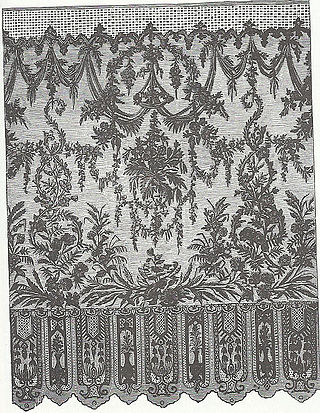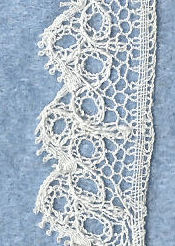
Lace is a delicate fabric made of yarn or thread in an open weblike pattern, made by machine or by hand. Generally, lace is split into two main categories, needlelace and bobbin lace, although there are other types of lace, such as knitted or crocheted lace. Other laces such as these are considered as a category of their specific craft. Knitted lace, therefore, is an example of knitting. This article considers both needle lace and bobbin lace.

Bobbin lace is a lace textile made by braiding and twisting lengths of thread, which are wound on bobbins to manage them. As the work progresses, the weaving is held in place with pins set in a lace pillow, the placement of the pins usually determined by a pattern or pricking pinned on the pillow.

Chantilly lace is a handmade bobbin lace named after the city of Chantilly, France, in a tradition dating from the 17th century. The famous silk laces were introduced in the 18th century. Chantilly lace, was also produced in the 19th century but this one was actually made not in Chantilly area but in the French Norman town Bayeux and in Geraardsbergen, now in Belgium.

Tønder lace is a point-ground type of handmade bobbin lace identified with the Tønder region of Denmark since about 1850, although lace of many types has been made there since as early as 1650. The term is also used more broadly, to refer to any bobbin lace made in Denmark.

Point de Gaze is a needle lace from Belgium named for the gauze-like appearance of the mesh ground. It was made from the early to mid 1800s to sometime between 1914 and the 1930s.

Antwerp lace is a bobbin lace distinguished by stylized flower pot motifs on a six point star ground. It originated in Antwerp, where in the 17th century an estimated 50% of the population of Antwerp was involved in lace making. Antwerp lace is also known, from its familiar repeated motif, as Pot Lace— in Dutch Pottenkant or Potten Kant. It is sometimes said that the flowers were a depiction of the Annunciation lilies; however, the flowers were not limited to lilies.

Gimp is a narrow ornamental trim used in sewing or embroidery. It is made of silk, wool, polyester, or cotton and is often stiffened with metallic wire or coarse cord running through it. Gimp is used as trimming for dresses, curtains, furniture, etc. Originally the term referred to a thread with a cord or wire in the center, but now is mainly used for a trimming braided or twisted from this thread. Sometimes gimp is covered in beads or spangles.

Valenciennes lace is a type of bobbin lace which originated in Valenciennes, in the Nord département of France, and flourished from about 1705 to 1780. Later production moved to Belgium, in and around Ypres. The industry continued onto the 19th century on a diminished scale. By the 19th century Valenciennes lace could be made by machine.

Mechlin lace or Point de Malines is an old bobbin lace, one of the best known Flemish laces, originally produced in Mechelen. Worn primarily during summer, it is fine, transparent, and looks best when worn over another color. Used for women's clothing, it was popular until the first decade of the 20th century. It was made in Mechelen, Antwerp, Lier and Turnhout. It was used for coiffures de nuit, garnitures de corset, ruffles and cravats.

Brussels lace is a type of pillow lace that originated in and around Brussels. The term "Brussels lace" has been broadly used for any lace from Brussels; however, strictly interpreted, the term refers to bobbin lace, in which the pattern is made first, and the ground, or réseau added, also using bobbin lace. Brussels lace is not to be confused with Brussels point, which is a type of needle lace, though sometimes also called "Brussels lace".

Blonde lace is a continuous bobbin lace from France that is made of silk. The term blonde refers to the natural color of the silk thread. Originally this lace was made with the natural-colored silk, and later in black. Most blonde lace was also made in black. It was made in the 18th and 19th centuries. The pattern, which is generally of flowers, is made with a soft silk thread, thicker than the thread used for the ground. This causes a big contrast between the flowers and the ground. It uses the same stitches as Chantilly lace and Lille lace, and is similarly made in strips 5 in (13 cm) wide and invisibly joined. Blonde lace is not as good as Chantilly lace though, as the ground is not as firm, nor is the pattern as regular.

Torchon lace is a bobbin lace that was made all over Europe. It is continuous, with the pattern made at the same time as the ground. Typical basic stitches include whole stitch, half stitch, and twists, and common motifs include spiders and fans. Torchon lace was notable historically for being coarse and strong, as well as consisting of simple geometric patterns and straight lines. It did not use representational designs, for the most part.

Binche lace is a type of bobbin lace that originated in the town of Binche, Belgium. It is continuous, meaning it is made all at once, in one piece. It is generally made in strips 2 inches (5 cm) wide. Though typically it has no cordonnet outlining the design against the ground, occasional pieces are made with a very fine one, about the same thickness as the thread used in the pattern. The pattern in Binche lace is very detailed, with animal scenes and figures.

Bedfordshire lace is a style of bobbin lace originating from Bedfordshire in the 19th century, and made in the English Midlands lacemaking area. It was worked as a continuous width on a bolster pillow. It is a guipure style of lace.

Bayeux lace was bobbin lace that was made at Bayeux in Normandy, France.

Mesh grounded lace is a continuous bobbin lace also known as straight lace. Continuous bobbin lace is made in one piece on a lace pillow. The threads of the ground enter motifs, then leave to join the ground again further down the process, all made in one go. This is different from part lace, where the motifs are created separately, then joined together afterwards.

Point de Paris is a French bobbin lace of the 18th century, with slender trailing designs in a point de Paris ground. It was a simple lace, and did not compete with those of Flanders. It was revived in the late 19th century for trimming lingerie and 'fancy linen'.

Flanders lace was made in Flanders, which was particularly well known for its bobbin lace. The supreme epoch of Flemish lace lasted from about 1550-1750.
Bobbin lace ground is the regular small mesh filling the open spaces of continuous bobbin lace. Other names for bobbin lace ground are net or réseau. The precise course of the threads and the resultant shape of the ground are an important diagnostic feature in lace identification, as different lace styles use different grounds.

Ipswich lace is a historical fashion accessory, the only known American hand-made bobbin lace to be commercially produced. Centered in the coastal town of Ipswich, Massachusetts north of Boston, a community of lacemaking arose in the 18th century. Puritan settlers to the area likely made and wore lace as early as 1634, because Sumptuary laws from the early colonial records indicate this activity. In fact, the earliest known record of the act of lacemaking in the region comes from a court case in 1654 associated with the home of Governor John Endicott. An indentured servant in the household accused the governor's son Zerubbabel with assault, which occurred while she was working at her lace cushion. Earliest known records of the commercial production indicate that lace produced by local women was used to barter for goods in the 1760s, as denoted by ledger account books belonging to local merchants. These laces were sold in the region from Boston to Maine.




















